Shortened 2020 Census Timeline Will Shortchange Southeast Asian American Communities
September 30 field data collection deadline insufficient for complete count of communities of color
Washington, DC – SEARAC
denounces the U.S. Census Bureau’s decision to rush the census in the midst of a worsening pandemic and with the most difficult work ahead. Announced Monday by Census Bureau Director Steve Dillingham, the new
September 30, 2020 deadline for field data collection and for community members to self-respond to the census is an abandonment by this administration of its own previous request to extend the deadline to October 31, 2020.
With the national response rate hovering just over
60 percent, the new deadline leaves the Census Bureau staff with even less time to count the households who have not yet responded. Having already had to delay their field work to assist community members with responding, including mobile questionnaire assistance and door-to-door enumeration of households, due to coronavirus social distancing measures, the Census Bureau is shortchanging critical operations to count the remaining 40 percent of Americans. The communities who will pay the highest price for a rushed census are people of color, low-income people, and people experiencing homelessness – communities who are already historically harder to reach and undercounted in any given census year.
According to 2010 Census data, over
650,000 Southeast Asian Americans lived in harder-to-reach tracts, or areas with the lowest self-response rates in the country. An incomplete count of Southeast Asian American communities risks their fair share of over $1.5 trillion in federal funding and political representation over the next 10 years.
“The Census Bureau’s decision to shorten their timeline is counterproductive to the purpose of the decennial census – to get a full and accurate count of everyone. For too long, Southeast Asian American communities have lived first hand with inadequate funding and political representation as a result of incomplete census data,” said Quyen Dinh, executive director of SEARAC. “The 650,000 Southeast Asian Americans living in ‘hard-to-count’ tracts do not deserve to be shortchanged for another ten years. Our communities deserve our fair share of resources and representation for the next decade. We call on Congress to act to give this once-a-decade task the time it requires without cutting corners. SEARAC urges Congress to vote to extend the statutory deadlines for reporting apportionment and redistricting data and to allocate $400 million to address the challenges brought about by the coronavirus pandemic.”
ACTION ALERT: Take a few minutes to call or email your senator NOW
1. Call the US Capitol Switchboard at
(202) 224-3121 and ask to speak with your Senate member. You can also click
here to find the direct lines to your senator.
2. Find your senator’s email
here.
3. Find sample language below:
Hi, my name is _______ and I am your constituent from (City and State). I am calling/writing to ask you NOT to cut the 2020 Census short and to extend the reporting deadline so the Census Bureau has the time it needs to count everyone in our state. A rushed census results in an inaccurate representation of the country. We need a full and accurate count of our communities in (State). Thank you for your time.
2020 Census Instructions Translated for Iu Mien Community
Washington, DC – In partnership with Sacramento-based
Iu-Mien Community Services, Southeast Asia Resource Action Center (SEARAC) recently added the
Iu Mien translation of the 2020 Census questionnaire to its newly launched
2020 Census website. The US Census Bureau will be providing language guides in 59 non-English languages, including
Hmong,
Khmer,
Laotian, and
Vietnamese. Census Bureau will also allow households to respond online, as well as receive assistance via phone, in 12 non-English languages, including Vietnamese.
SEARAC’s
census website serves as a resource about the decennial US population count with specific information on its impact on Southeast Asian American (SEAA) communities. The site includes county-level SEAA population data and maps based on the 2010 Census, along with translated factsheets, frequently asked questions, training opportunities, social media shareables, census news, and more.
“We thank Iu-Mien Community Services for providing this first-of-its-kind resource for the 30-45,000 members of the Iu-Mien community living in the United States,” said Quyen Dinh, executive director at SEARAC. “Southeast Asian American refugee community members across the country have spent the last 45 years laying the foundation for new chapters of their lives; we and our future generations cannot afford to miss out on the federal funding, government resources, and political representation that we deserve. Our time is now.”
Every 10 years, the US government is required to count every person living in the United States through the census. The 2020 Census will begin next month, and it will determine how $1.504 trillion in federal funding will be allocated to state and local government-funded programs, such as food stamps, Section 8 housing, public health insurance, roads, schools, and more, on which many SEAA families rely. For example, 41% of Hmong, 36% of Cambodian, and 31% of Lao and Vietnamese Americans use public health coverage, totaling more than 254,000 households; furthermore, 24% of Hmong, 18% of Cambodian, 14% of Lao, and 11% of Vietnamese Americans use food stamps, totaling more than 102,000 households.
“It is critical to remove any possible barrier for participation in order for each and every person in our communities to be counted,” said Kao Thun, executive director of Iu-Mien Community Services. “That is why it was so important for us to step up and create something that the US Census Bureau does not offer. We need a full and accurate count to understand the unique needs of all our diverse, ethnic communities, including the Iu-Mien community.”
To learn more information on how the census will impact Southeast Asian American communities, visit
www.searac.org/SEAAsCount.
SEARAC Launches 2020 Census Website for Southeast Asian Americans
Washington, DC – SEARAC today launched its
2020 Census website, a resource about the decennial US population count with specific information on its impact on Southeast Asian American (SEAA) communities. The site includes county-level SEAA population data and maps based on the 2010 Census, along with translated factsheets, frequently asked questions, training opportunities, social media shareables, census news, and more.
“Many Southeast Asian Americans are vulnerable to barriers that make it challenging for them to get counted during the census,” said Alyssa Tulabut, field manager at SEARAC. “It is our hope that this resource can further support the efforts of those on the ground who are working hard to ensure an accurate count of SEAA communities.”
“Forty-five years ago, our communities arrived to the United States as the largest refugee community to resettle in this country,” said Quyen Dinh, executive director at SEARAC. “Accurate Census data have the power to tell the story of our ongoing journey to equity. Even further, data will help our current and future generations receive the support and political representation we deserve.”
For questions related to the 2020 Census, please contact Alyssa Tulabut at
alyssa@searac.org.
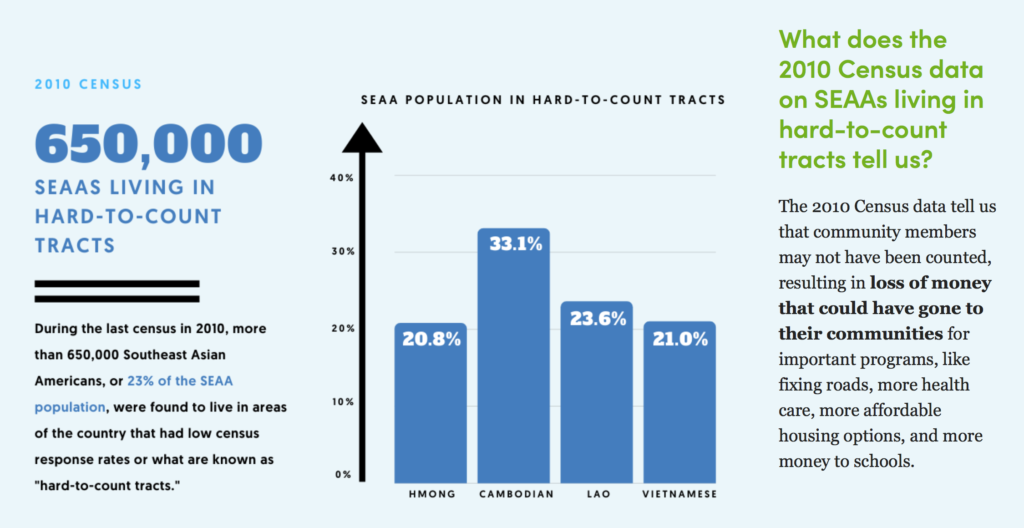
A screenshot showing hard-to-count data from our 2020 Census website
SEARAC Launches Translated Census Factsheets for the Southeast Asian American Community
Factsheets discuss census impact on the general SEAA community, immigrants, elders, young adults, and children and youth
Washington, DC – Today, SEARAC is proud to launch census factsheets for the Southeast Asian American (SEAA) community translated into five languages: Khmer, Lao*, Hmong, Vietnamese, and Mien. These resources, along with the English versions launched in August, are meant to bolster education and encourage participation among SEAA communities that have been historically harder to reach and harder to count, including:
“We are thankful to our partners for translating these materials in order to make them more accessible for all community members,”said Katrina Dizon Mariategue, director of national policy at SEARAC. “Through the generous support and expertise of BPSOS-Houston, Freedom Inc, the Fresno Center, Iu-Mien Community Services, and the Cambodian Family, we are excited to share these new resources, which we hope will support our community partners in educating and mobilizing SEAAs to get-out-the-count next year. While the public is welcome to download and share the resources as is, we also encourage individuals to edit and tailor them for their own needs in their local communities.”
During the last census in 2010, more than 650,000 SEAAs, or 23% of the SEAA population, were found to live in areas of the country that had low census response rates.1,2 Additionally limited-English proficiency continues to be a challenge for many SEAAs to census participation. The 2011-2015 American Community Survey reveals that roughly 38.3% of Cambodian, 36.7% of Hmong, 34.5% of Lao, and 48.6% of Vietnamese households speak English less than “very well,” compared to 8.6% of total US households.3 This means that these community members may be vulnerable to an undercount, resulting in loss of money that could have gone to their communities for important programs, like fixing roads, more health care, more affordable housing options, and more money to schools.
“Our communities have grown in number since our initial resettlement into the country following the US occupation in Southeast Asia decades ago, yet we continue to remain invisible,” said Quyen Dinh, executive director at SEARAC. “The census is a critical program that facilitates the collection of national disaggregated data, which is key to advocacy for policies that promote equity among SEAAs. We hope that these resources inspire the power and potential that our community carries to fight for our own self-determination by participating in the 2020 Census.”
Consider signing up to be a SEARAC Census Ambassador to educate your community and get out the count by signing up
here.
*Our previously published Lao factsheets have been updated to show the correct versions.
SEARAC Census Factsheets Available in Khmer
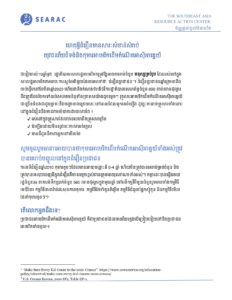 SEARAC recently launched its first set of census factsheets to bolster education and civic participation among Southeast Asian Americans (SEAAs) in 2020. See these factsheets translated in Khmer, below:
SEARAC recently launched its first set of census factsheets to bolster education and civic participation among Southeast Asian Americans (SEAAs) in 2020. See these factsheets translated in Khmer, below:
SEARAC Census Factsheets Available in Iu Mien
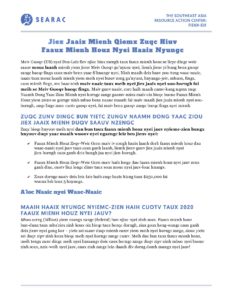 SEARAC recently launched its first set of census factsheets to bolster education and civic participation among Southeast Asian Americans (SEAAs) in 2020. See these factsheets translated in Iu Mien, below:
SEARAC recently launched its first set of census factsheets to bolster education and civic participation among Southeast Asian Americans (SEAAs) in 2020. See these factsheets translated in Iu Mien, below:
![]()
SEARAC Census Factsheets Available in Vietnamese
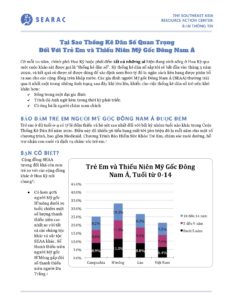 SEARAC recently launched its first set of census factsheets to bolster education and civic participation among Southeast Asian Americans (SEAAs) in 2020. See these factsheets translated in Vietnamese, below:
SEARAC recently launched its first set of census factsheets to bolster education and civic participation among Southeast Asian Americans (SEAAs) in 2020. See these factsheets translated in Vietnamese, below:
![]()
SEARAC Census Factsheets Available in Hmong
SEARAC recently launched its first set of census factsheets to bolster education and civic participation among Southeast Asian Americans (SEAAs) in 2020. See these factsheets translated in Hmong, below:
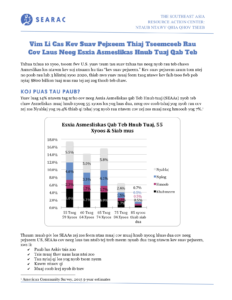
![]()
SEARAC Census Factsheets Available in Lao
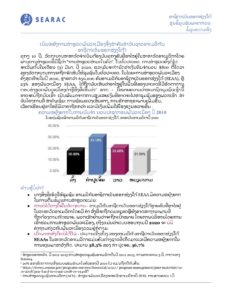 SEARAC recently launched its first set of census factsheets to bolster education and civic participation among Southeast Asian Americans (SEAAs) in 2020. See these factsheets translated in Lao, below:
SEARAC recently launched its first set of census factsheets to bolster education and civic participation among Southeast Asian Americans (SEAAs) in 2020. See these factsheets translated in Lao, below:
![]()
SEARAC Launches Census Factsheets for the Southeast Asian American Community
Washington, DC – Today, SEARAC launched its first set of census factsheets to bolster education and civic participation among Southeast Asian Americans (SEAAs) in 2020. These resources, which will be translated in-language, target the general SEAA community, in addition to communities that are historically harder to reach and harder to count, including:
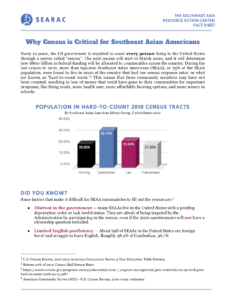
![]()
Mandated by the US constitution, the census is charged with counting every single person living in the country. The data are critical in deciding how to allocate $800 billion in federal funding for education, health, transportation, infrastructure, and many other programs and services for all families and communities. Data also greatly impact federal representation in Congress, which is key to ensuring that all voices are heard, and all people are seen.
“We are so excited to share these new resources, which we hope will support our community partners in educating and mobilizing SEAAs to get-out-the-count next year,” said Katrina Dizon Mariategue, director of national policy at SEARAC. “The SEAA-specific data are meant to demonstrate both the impact and need to get counted to ensure adequate resources and representation for SEAAs, in addition to addressing common concerns and questions community members may have around participation. While the public is welcome to download and share the resources as is, we also encourage individuals to edit and tailor them for their own needs in their local communities.”
During the last census in 2010, more than 650,000 SEAAs, or 23% of the SEAA population, were found to live in areas of the country that had low census response rates.1,2 This means that these community members may have not been counted, resulting in loss of money that could have gone to their communities for important programs, like fixing roads, more health care, more affordable housing options, and more money to schools.
“Our communities have grown in number since our initial resettlement into the country following the US occupation in Southeast Asia decades ago, yet we continue to remain invisible,” said Quyen Dinh, executive director at SEARAC. “The census is a critical program that facilitates the collection of national disaggregated data, which is key to advocacy for policies that promote equity among SEAAs. We hope that these resources inspire the power and potential that our community carries to fight for our own self-determination by participating in the 2020 Census.”
Consider signing up to be a SEARAC Census Ambassador to educate your community and get out the count by signing up
here.
REFERENCES
1. U.S. Census Bureau, 2011-2015 American Community Survey 5-Year Estimates, Table B16004.
2. Bottom 20% of 2010 Census Mail Return Rates

 SEARAC recently launched its first set of census factsheets to bolster education and civic participation among Southeast Asian Americans (SEAAs) in 2020. See these factsheets translated in Khmer, below:
SEARAC recently launched its first set of census factsheets to bolster education and civic participation among Southeast Asian Americans (SEAAs) in 2020. See these factsheets translated in Khmer, below: SEARAC recently launched its first set of census factsheets to bolster education and civic participation among Southeast Asian Americans (SEAAs) in 2020. See these factsheets translated in Iu Mien, below:
SEARAC recently launched its first set of census factsheets to bolster education and civic participation among Southeast Asian Americans (SEAAs) in 2020. See these factsheets translated in Iu Mien, below:  SEARAC recently launched its first set of census factsheets to bolster education and civic participation among Southeast Asian Americans (SEAAs) in 2020. See these factsheets translated in Vietnamese, below:
SEARAC recently launched its first set of census factsheets to bolster education and civic participation among Southeast Asian Americans (SEAAs) in 2020. See these factsheets translated in Vietnamese, below: 
 SEARAC recently launched its first set of census factsheets to bolster education and civic participation among Southeast Asian Americans (SEAAs) in 2020. See these factsheets translated in Lao, below:
SEARAC recently launched its first set of census factsheets to bolster education and civic participation among Southeast Asian Americans (SEAAs) in 2020. See these factsheets translated in Lao, below: 


